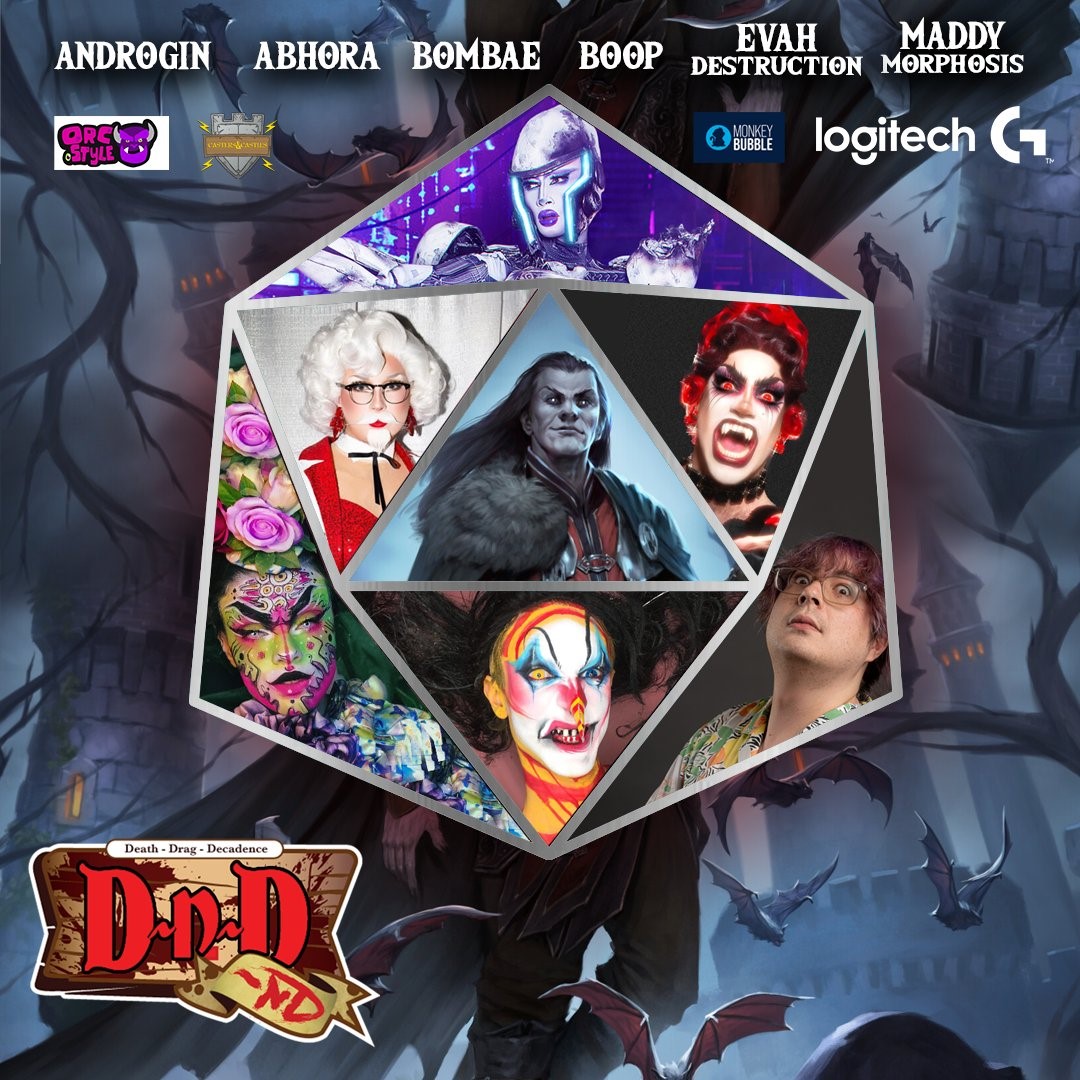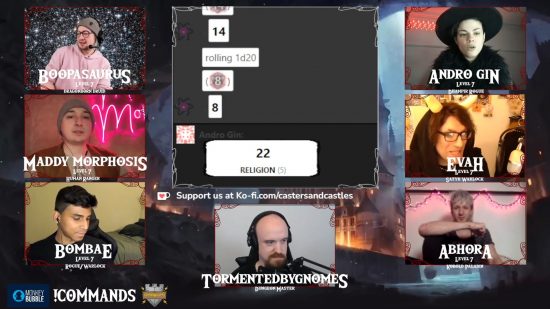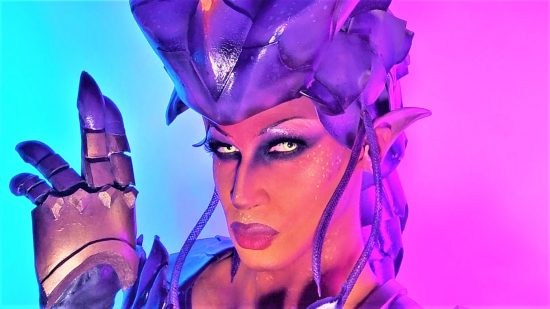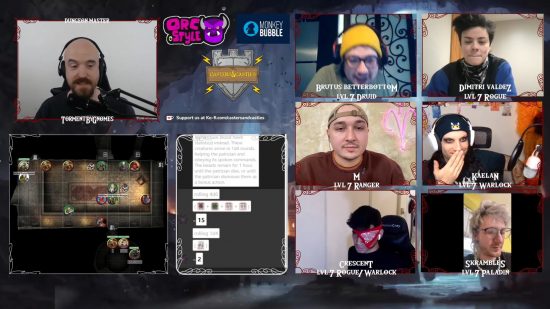Drag has a surprising amount in common with Dungeons and Dragons. Both communities are filled with passionate performers who pour time, love (and occasionally glitter) into a character of their own creation. Both are also perfect platforms for queer joy. Case in point: Death, Drag, and Decadence, a Dungeons and Dragons actual play series that also happens to star DnD drag queens and kings.
Death, Drag, and Decadence describes itself as “a celebration of all things queer and fantasy”. Most of the cast are experienced drag artists, with alumni from Ru Paul’s Drag Race and Dragula seated at the table. Evah Destruction, Maddy Morphosis, Bombae, Abhora, and Andro Gin make up the current adventuring party.
With the first drag stream airing in March, Bombae was one of the first queens to join the show. She’s the self-described winner of Canada’s Drag Race season three (citation needed), and she has a long history with tabletop gaming. “I played board games growing up, and I think I played Dungeons and Dragons for the first time in India ten years ago”, Bombae tells Wargamer.
“I used to play and DM before I became a drag queen”, she continues. “That was the more expensive hobby that took over my life, but I really missed [D&D].”
It’s not all dungeons and drag queens, though. ESports personality Chris Lessard (AKA Boopasaurus) dreamt up Death, Drag and Decadence, and he’s been a player in the early adventures.
“Death, Drag, and Decadence was originally just an excuse for me to find a way to play D&D”, Lessard tells Wargamer. “I had just finished watching a season of Dragula, and I thought this would be a group of people who’d be good at playing D&D – drag kings and queens and drag artists.”
Lessard also roped in Casters and Castles’ Joseph Carothers (TormentedByGnomes) – who Lessard reckons “is the next Matt Mercer” – to DM. Carothers is pretty new to the drag scene, but he’s got plenty of experience running RPGs for those in eSports. “When I got the opportunity to work with drag performers, I thought: ‘This is just like that, except better’”, Carothers tells Wargamer.
“Here are performers who know that they are having fun but also entertaining and putting on a show by playing characters”, he adds. “They have the camera training, they have the public speaking training – it’s 100% in terms of roleplay as performance. It’s an absolutely natural fit.”

Death, Drag, and Decadence may feature drag artists playing D&D, but it’s by no means a drag show. Everyone is in plain-clothes mode, with not a single extravagant outfit in sight. According to Lessard, this was deliberate.
“Not being in drag was a very intentional decision”, he tells Wargamer. “Evah [Destruction] said something that really stuck with me – drag is her life, and she’s always in drag, and to have something not part of that to look forward to is super joyful.”
Bombae echoes this sentiment. “We as drag performers we love to perform”, she says. “We love putting on a show – but often, when you’re doing drag, there’s so much work that goes into it before you have to get into drag.”
“It’s very physical; you’re changing your body to go to a bar and perform.” “With D&D, you just show up”, she adds. “There are no barriers. We get to perform, but we don’t have to put all the armor on.”

It’s clear from the get-go that Death, Drag, and Decadence is about more than just drag. “I thought it’d be really cool to show queer joy and queer people having fun”, Lessard says. “We’re not outwardly political; our goal is to exist and have fun.”
“This is about finding people you like and feel safe with, and then having a good time for a few hours”, Lessard adds. “That’s why we play D&D: to escape our world. There’s a space for everybody, and that’s the point of D&D.”
Most seasons of Ru Paul’s Drag Race features drama of some kind, but Death, Drag, and Decadence struts to a different beat. Many of its cast were strangers before the stream began, and several still haven’t met in person. But Bombae, Lessard, and Carothers speak of the show and their fellow players with a love that’s difficult to contain.
“What’s been absolutely amazing is the internalized respect everyone has for each other when they perform”, Lessard tells Wargamer. “Everyone gets their opportunity, and everyone gets a moment in the spotlight.” “I think Gnomes is really good at giving us a world that facilitates our creativity”, he adds.

Bombae chimes in with support for Carothers. “Wrangling regular players is tough, but especially five queer people who love the attention and will not let go of the spotlight”, she says.
Carothers, a self-described “outsider to the drag scene”, returns this love in kind. “I’ve had the chance to meet all these people I wouldn’t have crossed paths with and whose time I really cherish as a showrunner for an actual play channel”, he tells Wargamer. “It’s been phenomenal getting to play with these people. They surprised me – especially the newbies – and it’s been a wonderful experience.”
Any player can tell you Dungeons and Dragons brings people together in a unique way. The rising popularity of D&D livestreams like Death, Drag, and Decadence is only making the game – and the joy it creates – more accessible.
“As streaming has picked up, and as videogames have gotten more sophisticated, there’s been more ways to scratch that ‘kick down the door, fight the monsters and take their treasure’ itch”, Carothers says. “This means the unique aspects of tabletop have been discovered by the wider community.”
“There are things you can only do in tabletop that aren’t possible in videogames”, he continues. “People see Critical Role and Dimension 20, and they say: ‘This is creativity. This is improv. This is cooperative storytelling with my friends. This isn’t just maths and spreadsheets and graph paper.’” “That has allowed the hobby to change – and expand”, Carothers adds.
“Women and the queer community, they’ve always been there, they’ve always been part of this team”, Carothers continues. “But the space for them has exploded because of that change in perception of what a tabletop RPG can be.” “The emergence of icons and models that have advocated and given them representation, and that appreciation of the absolute creative freedom tabletop gives you, has opened the door for so many more people”, he tells Wargamer.
Carothers also mentions the “low barrier to entry” that comes with streaming. However, this means the market is flooded with viewing options, and success is harder to find.
Even the unique selling point of Death, Drag, and Decadence isn’t entirely unique. Just as the show wrapped its first season, Dimension 20 announced its own drag actual play, Dungeons and Drag Queens.
Despite the crowded market, Lessard isn’t worried about competing. “I think we already stand out”, he tells Wargamer. “We have our main crew, which I think love each other, and we love hanging out with each other – that’s the basis of standing out, in my opinion.”
There are plenty of plans to expand Death, Drag, and Decadence. The current cast will continue playing together for a new chapter, as well as in a one shot focused on a particularly beloved character, Skrambles. Lessard says new DMs and drag artists will feature in the series. And while the bonds between players will no doubt deepen, Lessard also wants to build relationships with the show’s audience.
“I don’t want to keep this to people just in the drag community”, he says. “For example, I would love to add a community table.” This, he says, may feature some of its fans – or drag artists – in the DM seat, running games.
Death, Drag, and Decadence is an actual play that makes community and joy feel as important as rolling the DnD dice. It’s a perfect representation of Carothers’ number one rule for D&D: “People first”.
For more queer joy in D&D, here’s some tips on how to explore queerness safely in D&D, as well as how tabletop RPGs like DnD are an LGBTQ+ haven.


